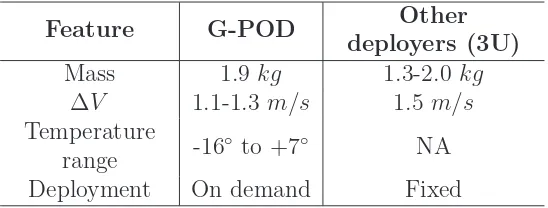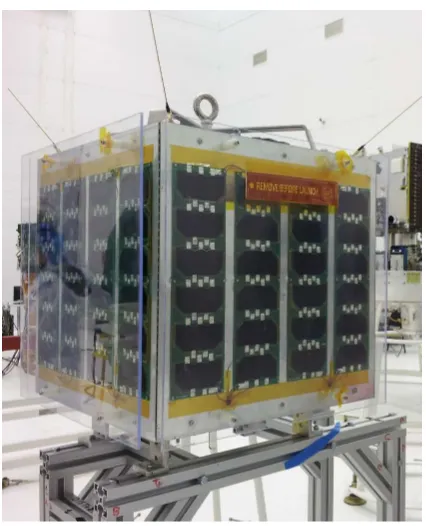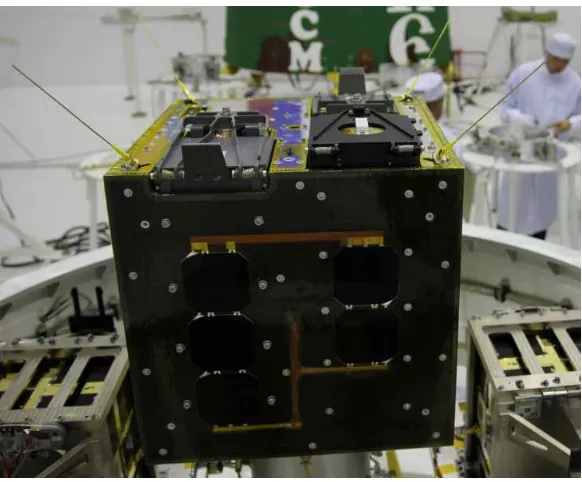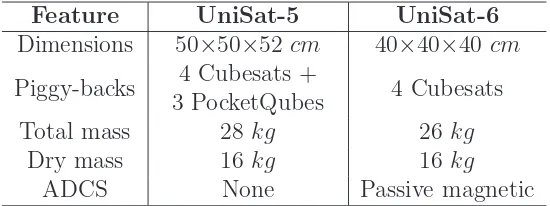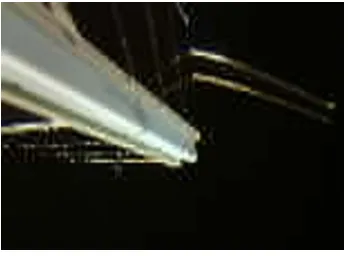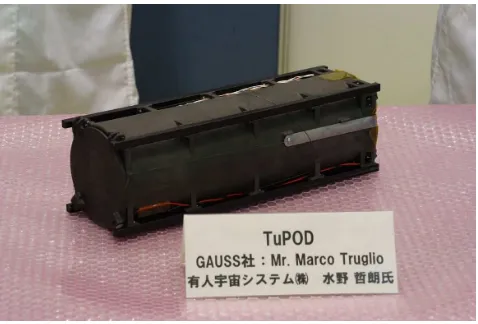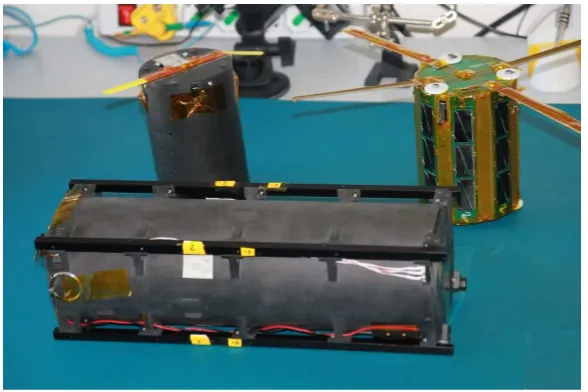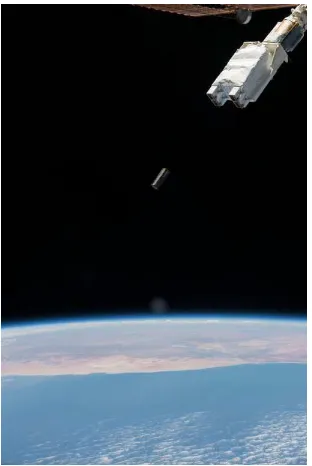Small launch platforms for micro-satellites
CAPPELLETTI, C, BATTISTINI, S. <http://orcid.org/0000-0002-0491-0226>
and GRAZIANI, F
Available from Sheffield Hallam University Research Archive (SHURA) at:
http://shura.shu.ac.uk/24855/
This document is the author deposited version. You are advised to consult the publisher's version if you wish to cite from it.
Published version
CAPPELLETTI, C, BATTISTINI, S. and GRAZIANI, F (2018). Small launch platforms for micro-satellites. Advances in Space Research, 62 (12), 3298-3304.
Copyright and re-use policy
See http://shura.shu.ac.uk/information.html
Small launch platforms for micro-satellites
Chantal Cappellettia,∗, Simone Battistinib, Filippo Grazianic a
Department of Mechanical, Materials and Manufacturing Engineering, University of Nottingham, University Park, NG7 2RD, Nottingham, UK
b
Faculdade Gama, Universidade de Bras´ılia, ´Area Especial de Ind´ustria Proje¸c˜ao A, 72.444-240, Gama, Brazil
c
GAUSS srl, Via Sambuca Pistoiese 70, 00138, Roma, Italy
Abstract
The number of small satellites launched into orbit has enormously increased in the last twenty years. The introduction of new standards of micro-satellites has multiplied the launch demand around the world. Nevertheless, not all the missions can easily have access to space: not all kinds of micro-satellites have granted a deployer system and, furthermore, once a micro-satellite is able to reach it, it cannot usually choose its final orbit. Recently two new platforms have been introduced for the release of micro-satellites as piggy-backs. These platforms are totally operative spacecrafts that act like motherships, and allow to select some parameters of the final orbit of the piggy-backs. They provide a solution for three different nano-satellites standard, and at the same time they are being developed in order to reach more powerful orbital release capabilities in the future. The design and the mission of these platforms are described in this paper.
Keywords: small satellites; launch systems; cubesats
1. Introduction
The last twenty years have seen a tremendous increase in the number of small satellites launched into orbit (Bouwmeester, & Guo, 2010). Small satellites are employed in several applications, ranging from educational
∗Corresponding author
Email addresses: chantal.cappelletti@nottingham.ac.uk(Chantal Cappelletti),
simone.battistini@aerospace.unb.br(Simone Battistini),
projects to remote sensing, science and communications (Heidt, Puig-Suari, Moore & al. , 2000; Sandau, Brieß & D’Errico, 2010; Sandau, 2010;Simms, Jernigan, Malphrus & al. , 2012; Manghi, Modenini, Zannoni & Tortora
, 2017). This versatility can be better exploited by creating constellations of small satellites, which have been recently proposed for several purposes, such as Earth observation, atmospheric measurements, and disasters manage-ment (Boshuizen, Mason, Klupar, & Spanhake,2014;Gill, Sundaramoorthy, Bouwmeester & al., 2013;Santilli, Vendittozzi, Cappelletti & al. , 2018). Of course, this poses more specific requirements on the in orbit release.
In a spacecraft project, the launch is one of the most critical phases; fur-thermore, it is troublesome for the launch provider to interact with a large number of small satellites customers. Several space systems and payloads have never been tested in space due to the limited budget for launch pro-curement.
The majority of small satellites are launched as secondary payloads in a so-calledcluster launch and they do not have much choice about the selection of their orbit. Furthermore, until some time ago, some micro-satellites did not either have the possibility to be launched since no launch systems able to deploy them in orbit were available. This was the case of PocketQubes and TubeSats, two recently proposed micro-satellite standards (Gill, Guo, Perez Soriano & al.,2016;Cappelletti , 2018).
Considering these restrictions, two new platforms have been developed by the italian company GAUSS (Group of Astrodynamics for the Use of Space Systems), namely the UniSat and the Tu-POD (Truglio, Rodriguez, Cappelletti & Graziani , 2015; Djamshidpour, Cappelletti, Twiggs & Biba ,
2013).
This paper describes the design of these platforms and the missions per-formed in the last years. It is organized as follows. Section 2 describes the main launch platforms for micro satellites worldwide; Section 3 presents the UniSat platform, its deployer systems and the in orbit results of the mis-sions launched so far; Section 4 describes the Tu-Pod satellite, the release mechanism and its in orbit results; conclusions are given in Section 5
2. Launch platforms for micro-satellites
Standardized deployers were one of the reasons for the success of Cube-Sats. Small satellites were already launched in the decades prior to 2000, employing different launchers for orbital insertion. Nevertheless, they all differ by the capability of payload delivery and the employed deployment actuator. The standardization of the interface with the launcher, therefore, has certainly been one of the most important factors in the large increase in launches of micro satellites. The deployer must protect the launcher from any interference with the satellites, minimize the spin and collision possibili-ties at release and work as a mechanical interface between the launcher and as many spacecrafts as possible (Nason, Puig-Suari, & Twiggs ,2001).
Along with the introduction of the CubeSats, it came the development of the first dedicated deployer, the P-POD (Puig-Suari, Turner & Ahlgren
, 2001). This system is attached to the launcher upper stage and allows the accommodation and in-orbit release of up to three CubeSats at the same time. The deployer activation time is previously scheduled and the spacecraft is released on the same orbit of the upper stage of the launcher. A small ∆V, guaranteed by a spring, provides the separation between the CubeSat and the launcher. Various similar systems have been introduced by other companies in the last years: the ISIS-POD, the RailPOD, the PSL-TPL, the XPOD, the NanoRacks and the J-SSOD are other examples of CubeSats deployer employed on several launchers and on the International Space Station. The modularity of these systems allows to realize bigger deployers that can launch up to 28 3U CubeSats.
access to space is reduced since small satellites launch providers can negotiate higher volumes of mass on board the launchers. On the other hand, these systems are not ready yet to perform more complete missions that would require specific in-orbit release conditions, like time-delayed release or small orbital maneuvers, for example.
Micro satellites constellations pose more strict requirements on the release systems. Therefore, there is a need for different, more autonomous deployers that could guarantee placing a satellite on the needed orbit and not just release it when and where it is possible. Another necessity that arose in the last years is to provide access to space to other platforms besides CubeSats, such as PocketQubes and TubeSats, even though the latter still have a smaller market than that of the former. The next sections will present two platforms that represent a first attempt to solve the issues of common micro satellites deploying systems. The UniSat and the Tu-Pod platforms are two versatile, completely autonomous satellites that can release in orbit different kinds of micro satellites.
3. The UniSat platform
The history of the UniSat platform dates back to the end of the 1990s, when the first satellite of the series was designed, manufactured and launched by the Scuola di Ingegneria Aerospaziale di Roma. After four satellites launched from 2000 to 2006, the newly-established company GAUSS took over in 2012 and UniSat became a private project whose main goal was to serve as a platform for launching other micro-satellites. The mission of UniSat-5 in November 2013 was the first ever commercial launch in which a satellite carried on board and released in orbit other piggy-back satellites for commercial use. Furthermore, this was also the first time that PocketQubes were flown in space.
Feature G-POD Other deployers (3U)
Mass 1.9 kg 1.3-2.0 kg
∆V 1.1-1.3 m/s 1.5 m/s
Temperature
[image:6.612.169.443.125.229.2]range -16◦ to +7◦ NA Deployment On demand Fixed Table 1: G-POD and other deployers main features
2013). Nowadays, UniSat is one of the two platforms for the release of micro-satellites that is looking forward to achieve this capability (Andrews,2012). A necessary condition for performing these orbital maneuvers with the UniSat platform is the availability of an on-board attitude determination and control system (ADCS). The first step in this direction was the implementation of a passive magnetic control system on board UniSat-6. An active ADCS has been proposed for boarding in the future UniSats (Battistini, Cappelletti & Graziani ,2016).
In the following, the design of the UniSat spacecrafts will be presented, as well as the two missions of UniSat-5 and UniSat-6.
3.1. Design of UniSat-5 and UniSat-6
Figure 2: The UniSat-6 spacecraft integrated on the launch platform
Both satellites used the same communication system, consisting in a UHF radio and 4 antennas, and the same OBDH, based on the ABACUS computer (Nascetti, Pancorbo D’ Ammando & Truglio , 2013). Both were designed to maintain an internal thermal range between -10◦C and 10◦C. Power is
provided by body-mounted solar panels, which provide from 5 W (bottom panel) to 11 W (4 side panels) of electrical power.
UniSat-6 had a passive magnetic attitude control system, made of a per-manent magnet and hysteresis rods; the stabilization of the spacecraft was verified through the data collected from the attitude sensors (magnetometers and rate gyros) (Battistini, Cappelletti & Graziani,2016). UniSat-6 had also a camera to take pictures of the Cubesats at the ejection from the mothership and for low-resolution Earth observation images. The main features of the two spacecrafts are resumed in Table 2.
3.2. In orbit missions
Feature UniSat-5 UniSat-6 Dimensions 50×50×52 cm 40×40×40cm
Piggy-backs 4 Cubesats +
3 PocketQubes 4 Cubesats
Total mass 28kg 26 kg
Dry mass 16kg 16 kg
[image:9.612.168.443.125.228.2]ADCS None Passive magnetic
Table 2: UniSat-5 and UniSat-6 main features
21, 2013 and the latter on June 19, 2014. The final orbit was in both cases a near Sun-synchronous orbit above 600 km of altitude. UniSat-5 carried on board four Cubesats (PUCP-Sat-1 from Per`u, ICUBE-1 from Pakistan, HUMSAT-D from Spain, and Dove-4 from USA) and four PocketQubes (QB-Scout, Eagle1 and 2 from USA, and WREN from Germany), while there were other four Cubesats (Tigrisat from Italy/Iraq, Lemur 1 from USA, An-telSat from Uruguay, and AeroCube6 from USA) riding on UniSat-6. All the satellites team involved in the mission demonstrated prior to the launch the compliance of their spacecrafts with the 25-year-rules for space debris mitigation. In both missions, the customers were university groups as well as private companies.
The UniSat-5 mission established some records: it was the first time that a satellite released other satellites into space for commercial purposes; it released into orbit the first peruvian satellite; it was the first time that Pock-etQubes were flown. With the latter fact, the UniSat platform granted access to space for the first time to a very low-cost platform, which is crucial for researches with minimal budgets. No other systems allows the launch of PocketQubes so far.
Figure 3: Tigrisat release as seen from the UniSat-6 camera
[image:10.612.197.412.433.590.2]Figure 5: The Tu-Pod
4. The Tu-Pod
A TubeSat is a hexadecagon-shaped spacecraft assembled from a set of printed circuit boards. It can be classified as a picosatellite, since its weight is less than 0.75 Kg. The TubeSat envelope is almost a cylinder with an external diameter of 8.94 cm and 12.57 cm height. Due to their cylindrical shape, TubeSats cannot be accommodated in a standard CubeSat deployer, nor in any other existing device.
In the following, the design of the Tu-Pod and the in-orbit results of the first mission will be presented.
4.1. Design of the Tu-Pod
The Tu-Pod is directly analogous to a 3U CubeSat, with external dimen-sions of 34.5×10×10cm, as shown in Fig. 5. It consists of three main parts:
• Main section • Bottom section • Pusher system
The main section is made with SLS. The SLS method uses a laser as the power source to sinter powdered material. The material selected was the Windform XT 2.0, a material whose previous uses were mainly for automotive racing. The Windform XT 2.0 is a carbon micro-fiber reinforced polymer material commercialized by the italian company CRP technologies.
The main section intern is completely dedicated to the TubeSats and pusher system allocation. The inner dimensions of the spacecraft allows to host up to two TubeSats in a single mission. The main section hosts also the Tu-Pod door and four rails made in aluminum with anodized sliding sur-faces. TubeSats are installed in the unit by the front door. The front door is mounted to the Tu-Pod with a self-opening hinge; the door has a release mechanism consisting of a nichrome wire wrapped around a nylon bolt and connected to the electrical system that allows remote release. When a com-mand is issued by the system logic, the cutter activates and melts through the bolt; then, the door is opened, the spring pulls the pusher plate forward, and the TubeSats are ejected.
Figure 6: Integration of the TubeSats inside the Tu-Pod
The pusher system is composed of a push plate and a spring. The push plate is a simple, thin Windform XT 2.0 plate that allows the spring to ho-mogeneously push the spacecrafts during the ejection. The plate has a shape that permits to use part of the room dedicated to the push spring to accom-modate the TubeSats antennas. The push spring is made in 316 Stainless Steel. The number of coils has been designed so to limit the exit velocity of the TubeSats to 0.5m/sin accordance with ISS safety requirements imposed by JAXA and NASA for the launch from J-SSOD system.
4.2. First mission in orbit
The first mission of the Tu-Pod was realized in 2016/2017. The main goal was the launch of the first two TubeSats ever, namely TANCREDO-1 and OSNSAT (Tikami, Moura & Dos Santos , 2017). The three satellites right before the integration at GAUSS premises are shown in Fig. 6. The Tu-Pod was first integrated in the J-SSOD deployer from the japanese company JAMSS and then flown to the International Space Station (ISS) on board an HTV-6 rocket on December 9th
, 2016. After a month on board the ISS, the Tu-Pod was released into orbit on January 16th
Figure 7: The Tu-Pod being released by the ISS
The ejection of the two TubeSats successfully occurred after three days from the release. The two TubeSats were regularly transmitting indicating the success of the main mission of the Tu-Pod. The spacecraft continued trans-mitting until its reentry in the atmosphere, which took place some weeks later, due to the very low orbit in which the Tu-Pod was placed.
5. Conclusions
The number of small satellites launched per year has greatly increased re-cently. Small satellites are always increasing their functionalities, becoming every time more performant. Along with this growth, a new set of require-ments for in orbit insertions has been set. Smaller spacecrafts standards and the possibility of creating constellations of micro-satellites are now realities which the market of launch providers has to face.
Figure 8: Tu-Pod beacon as received in the GAUSS ground station in Roma
number of micro-satellites inside and releasing them in orbit at an adequate time.
The UniSat platform is able to release in orbit two different standards of micro-satellites, CubeSats and PocketQubes. UniSat’s first flight mission with this scope was in 2013, when it was the first time that a satellite released other satellites in space. As an operative, standalone platform, UniSat can perform other tasks such as test of new technologies and devices or remote sensing services.
The Tu-Pod is a satellite that allows to adapt the TubeSat standard to the dimensions of a regular Cubesat deployer, thus access to space to these kind of micro-satellites.
Acknowledgements
References
Andrews, J. 2012, Spaceflight secondary payload system (SSPS) and Sherpa Tug - A new business model for secondary and hosted payloads. In Pro-ceedings of the 26th Annual AIAA/USU Conference on Small Satellites, Technical Session V: Getting There, SSC12-V-6, AIAA, Logan, USA. Battistini, S., Cappelletti, C., & Graziani, F. 2015, An attitude
determina-tion and control system for a nano-satellite alternative launch platform, In Proceedings of the 67th International Astronautical Congress, IAC-15-C1.8.5, IAF, Guadalajara, Mexico.
Battistini, S., Cappelletti, C., & Graziani, F. 2015, Attitude determination for the UniSat-6 microsatellite, In Proceedings of the 66th International Astronautical Congress, IAC-16-C1.5.6, IAF, Jerusalem, Israel.
Battistini, S., Cappelletti, C., & Graziani, F. 2016, Results of the attitude reconstruction for the UniSat-6 microsatellite using in-orbit data, Acta Astronautica, 127, 87-94.
Boshuizen, C., Mason, J., Klupar, P., & Spanhake, S. (2014). Results from the planet labs flock constellation, In Proceedings of the 28th Annual AIAA/USU Conference on Small Satellites, Technical Session I: Private Endeavors, SSC14-I-1, AIAA, Logan, USA.
Bouwmeester, J., & Guo, J. (2010). Survey of worldwide pico-and nanosatel-lite missions, distributions and subsystem technology. Acta Astronautica, 67(7), 854-862.
Cappelletti C. (2018). Femto, pico, nano: overview of new satellite standards and applications. In Advances in Astronautical Sciences, Proceedings of the 4th IAA Conference on University Satellite Missions and CubeSat Work-shop (Vol. 163, pp. 503-510).
Gill, E., Sundaramoorthy, P., Bouwmeester, J., Zandbergen, B., & Reinhard, R. (2013). Formation flying within a constellation of nano-satellites: The QB50 mission. Acta Astronautica, 82(1), 110-117.
Gill, E. K. A., Guo, J., Perez Soriano, T., Speretta, S., Bouwmeester, J., Carvajal God´ınez, J., ... & Sundaramoorthy, P. P. (2016). Cubesats to pocketqubes: Opportunities and challenges. In Proceedings of the 67th International Astronautical Congress, IAC-16-B4.7.5, IAF, Guadalajara, Mexico.
Heidt, H., Puig-Suari, J., Moore, A., Nakasuka, S., & Twiggs, R. (2000). CubeSat: A new generation of picosatellite for education and industry low-cost space experimentation. In Proceedings of the 14th Annual AIAA/USU Conference on Small Satellites, Technical Session V: Lessons Learned - In Success and Failure, SSC00-V-5, AIAA, Logan, USA.
Manghi, R. L., Modenini, D., Zannoni, M., & Tortora, P. (2017). Preliminary Orbital Analysis for a Cubesat Mission to the Didymos Binary Asteroid System. Advances in Space Research. In press.
Marinan, A., Nicholas, A., & Cahoy, K. (2013). Ad hoc CubeSat constella-tions: Secondary launch coverage and distribution. In Proceedings of the IEEE Aerospace Conference (pp. 1-15), IEEE, Big Sky, USA.
Nascetti, A., Pancorbo D’Ammando, D. L., & Truglio, M. (2013). ABACUS advanced board for active control of university satellites. In Proceedings of the 2nd IAA Conference on University Satellite Missions and Cubesat Workshop, IAA-CU-13-08-01 (pp. 437-446), IAA, Roma, Italy.
Nason, I., Puig-Suari, J., & Twiggs, R. (2002). Development of a family of picosatellite deployers based on the CubeSat standard. In Proceedings of the IEEE Aerospace Conference (Vol. 1, pp. 1-1), IEEE, Big Sky, USA. Pontani, M., & Cappelletti, C. (2013), Cubesat collision risk analysis at
orbital injection, In Advances in Astronautical Sciences, Proceedings of the 23rd AAS/AIAA Space Flight Mechanics Meeting (Vol. 148, pp. 3111-3130).
of the IEEE Aerospace Conference (Vol. 1, pp. 1-347), IEEE, Big Sky, USA.
Sandau, R., Brieß, K., & D ’Errico, M. (2010). Small satellites for global coverage: Potential and limits. ISPRS Journal of photogrammetry and Remote Sensing, 65(6), 492-504.
Sandau, R. (2010). Status and trends of small satellite missions for Earth observation. Acta Astronautica, 66(1), 1-12.
Santilli, G., Vendittozzi, C., Cappelletti, C., Battistini, S., & Gessini, P. (2018). CubeSat constellations for disaster management in remote areas. Acta Astronautica, 145, 11-17.
Simms, L. M., Jernigan, J. G., Malphrus, B. K., McNeil, R., Brown, K. Z., Rose, T. G., ... & Wampler-Doty, M. (2012,). CXBN: a blueprint for an improved measurement of the cosmological x-ray background. In SPIE Optical Engineering+ Applications (pp. 850719-850719). International So-ciety for Optics and Photonics.
Tikami, A., Moura, C. O., & Dos-Santos, W. A. (2017) First On-Orbit Results from the Tancredo-1 Picosat Mission, In Proceedings of the 1st IAA Latin American Symposium on Small Satellites: Advanced Technolo-gies and Distributed Systems, Session 2: Latin America Small Satellites Projects I, IAA-LA-02-01, IAA, Buenos Aires, Argentina.
